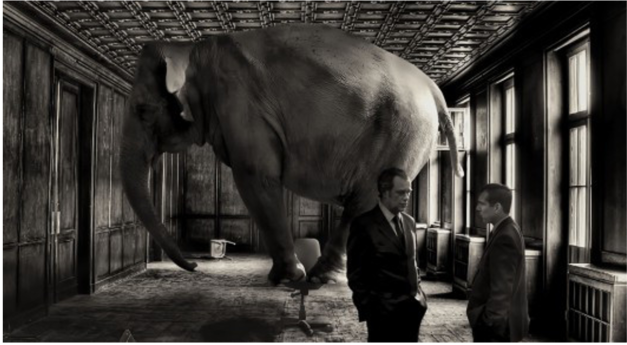Naming the Elephant in the Room

This Photo by Unknown Author is licensed under CC BY 3.0
Author: Jennifer Myers
You may remember the childhood party game of Pin the Tail on the Donkey (or Bunny or Pig—depending on the party theme), where dizzy, blindfolded partygoers are challenged to position a paper tail closest to the correct location. Others laugh at their inaccuracy, and the pinner always seems surprised at the reveal.
Similarly, meeting facilitators can also unintentionally veer off-course when their participants have hidden agendas, axes to grind, and group dysfunctions. These unspoken issues can fester and de-rail progress. An effective facilitation tool is “The Elephant in the Room,” which my MITRE colleague Marian Moriarty developed to surface those crucial issues to help ensure a productive session.
Here’s how it works: The facilitator posts a large graphic elephant, with sticky pads and pens for all participants. Next, the facilitator introduces the picture and invites the group to note anything that they consider to be an obstacle to the group’s meeting objectives.
At first glance, this technique may sound too simplistic to work—and truth be told, I was a skeptic before I tried it myself—but it has never failed me or my co-workers in numerous meetings with our sponsors. This image gives participants permission and the psychological safety to raise sensitive or uncomfortable issues, without fear of retribution.
For example, MITRE used The Elephant at the beginning of a working session with agency executives, who were asked to redesign the organizational structure of their own divisions. Immediately upon introducing this exercise, one of the participants raised several flags. This allowed the facilitators to address her fears, which others shared, through a group discussion. This important dialogue allowed the entire leadership team to debate, agree, and ultimately focus on what was the right design for the organization. This open process also helped reduce the participants’ inclination to protect their own turf.
The Elephant in the Room exercise works particularly well for leadership team-building off-sites, especially when using team performance models (e.g., Drexler-Sibbet, Tuckman). All teams have a lifecycle, which is not always a linear progression—but an evolution. This exercise can help a facilitator uncover issues that are impeding a group’s performance to help it progress in its maturity.
Without disclosing any entrusted details, when we have used this tool, The Elephants appear to fall into the following categories:
- Political issues: both the capital “P” for our government sponsors (e.g., Federal executive, legislative, oversight), as well as well as lowercase “p” interpersonal relationships (e.g., personalities, conflict)
- Personal feelings: job security (or lack there-of), guilt, confusion, marginalization
- Roles, responsibilities, and authority: particularly those that are informal
- Organizational culture: history, patterns, norms, behavior
- Leadership: participants have even labelled themselves as the elephant!
This facilitation tool also has the added benefit of providing the facilitator with unique insights into the group’s dynamics and history to improve the facilitator’s own effectiveness in guiding the session. A word of caution: This exercise should be used under the direction of a skilled professional. There is a real risk that the meeting can devolve into a gripe session or blame game. Establishing ground rules at the beginning of the session with the participants is especially important when applying this tool. For example:
- Treat each other with respect
- Vegas Rules (i.e., what happens here, stays here)
- Debate ideas, not people
What is more important than The Elephant is what the team does when The Elephant emerges. It is also important for the facilitator to acknowledge these elephants and help the group understand the influence, but not try to resolve these issues in the meeting. After allowing the discussion and considering the impacts, the facilitator should help the group redirect their energy toward making progress and achieving their original goal.
Meetings, workshops, and off-sites are expensive and time-consuming events—especially for busy leaders with many other demands on their time. The Elephant in the Room can help facilitators and participants “remove the blinders” and serve as a more productive and effective team.
Jennifer Myers is a Human and Organizational Systems Principal and the Human Capital Strategy Capability Leader. She specializes in organizational change management and workforce solutions for government agencies.
© 2018 The MITRE Corporation. All rights reserved. Approved for public release. Distribution unlimited. Case number 18-2206
MITRE’s mission-driven team is dedicated to solving problems for a safer world. Learn more about MITRE.
